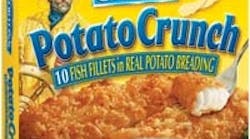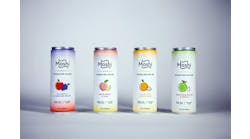Fish and chips started in the United Kingdom and reflected the growth of trawl fishing technology in the North Sea in the mid -800s. Trawlers landed both high quality and cheaper fish; the cheaper fish were used to make fish and chips.
The meal dominates take-out foodservice in the UK, Australia and New Zealand. In the U.S., fish and chip consumption has been driven by two factors: fast food restaurants specializing in this fare (Long John Silvers, Captain D's and Arthur Treacher's) and Catholics looking for fish meals to eat on Fridays, especially during Lent. This created a market for fried fish, often whitefish, served with french fries, potato salad, macaroni salad and/or coleslaw. The coating on the fish was either bread crumbs or a flour-based batter.
Gorton's Potato Crunch fish fillets
Over the years, the role of the batter has changed. Originally, the batter was not eaten, but was rather a covering for the fragile fish so it would be steamed; the casing of batter was discarded. Over time, the batter became rather tasty and it became part of the fish experience.
For Gorton's, as people have reconsidered traditional meals, the need to redefine fish and chips became apparent. Consumers are eating fewer side dishes with their meals and have less time to create a meal with a main course plus two sides. What better way to redefine the meal than to consider the entire fish and chips plate and combine what has been served separately?
Since potatoes are typically on the plate with the fried fish, why not put them on the fish? This requires only a single side dish — make it a green vegetable — giving the entire meal a healthier glow.
Understanding the marketplace
The health halo surrounding the fish and seafood category has been confusing for people. While the nutritional/medical community strongly supports this low-fat protein source, which contains omega-3 fatty acids, many health warnings have been issued from the government concerning mercury levels in fish.
The fish and seafood category market size is $16.4 billion, with sales of fish and seafood increasing by 31 percent between 2001 and 2006, according to Mintel Intl. Fresh fish has 57 percent of the market, frozen has 31 percent and canned has 12 percent. The frozen fish category is $5 billion and has grown at a rate of 29 percent since 2001. Even though religion is considered to be in flux with people today, 35-40 percent of frozen fish sales occur during the Lent season. Key brands in this category are Gorton's, Van de Kamp's, Sea Fresh and private label.
Less time and fewer cooking skills have reduced the time for food preparation. At least half of all households say they are too tired, due to their busy lives, to create elaborate dinners. Younger consumers don't want to take the time -- 60 percent of consumers aged 18-34 say they don't have the time to use to create dinner versus 33 percent of those over 55 years old. Similarly, 56 percent of households with annual incomes exceeding $50,000 a year also say they are too busy for long-form meal preparation versus 41 percent of households making less than $25,000 a year, according to a 2003 ACNielsen study.
Competition comes from restaurant take-out/pick-up; overall, one out of every four meals and snacks comes from restaurant food, according to Mintel. Americans have been spending 47 percent of their food dollars on restaurant food, according to USDA.
With this change in delivery of meal options, there has been a redefinition of what traditional meals are. Traditional meals are expected to be high-fat, high-calorie and not so healthy. Changing assumptions about traditional meals so they can compete with less traditional meal options means shaking up what is on the plate.
Gorton's is using a familiar, "traditional" brand to ask consumers to rethink traditional meal options, to create a new entree that is more "cuisine," delivering familiar, comforting flavors and textures and that are a bit different than many other options. The company is delivering a familiar meal with a cuisine-like twist that kids and mom (the gatekeeper) can feel good about.
According to our It!s Convenient, Crave It! and Healthy You! conjoint studies, the key attributes for frozen fish are taste, price, appearance, portion size, health, texture, brand, quality and amount of fat. When compared to frozen meals, texture is more important for frozen fish. When consumers have to make trade-offs, the key ideas for frozen fish are about moist, flaky whole fish fillets; heart-healthy omega-3s; reducing the risk of heart disease and diabetes; flavors; essential minerals; all-natural; crunchy breading; fresh frozen; low fat/low cholesterol. While looking for good taste, consumers also are looking for a healthy meal.
The key trends in frozen fish are value, heath and flavors.
Value: Fresh fish has positioned itself as the superior product versus frozen, but frozen fish, by focusing on quality and selection, has created a different definition of value beyond just lower price.
Taste: Frozen fish has moved to a variety of flavors including wine, butter, chipotle peppers and fresh garlic, and now to more complex adult flavors such as tequila lime and Caesar parmesan.
Healthfulness: Fish has always had a healthy halo, and it becomes even more important as more research is done on the health-related benefits of "good" fats and diets high in seafood. Using fresh fish is not always as convenient as frozen. Frozen fish has the ability to allow consumers access to simple, easy, good-quality healthy meals.
The experience
Gorton's Potato Crunch fish fillets are available in a 10-fillet package at $4.99–6.99. The package has the traditional yellow background with the fisherman. Potato crunch and "great potato chip flavor" are called out on front, along with an image of ridged potato chips.
When we brought this to our consumer taste-testers, some missed the difference when quickly scanning, since they were looking only for the food beauty shot and fisherman on the front. Preparation was by conventional oven cooking, so the product fits easily into the expected preparation norms for this meal.
The baked color was a lighter golden brown than the traditional breaded fish fillet, yet very pleasant and not unexpected for a breaded fish fillet. The flavor was of potato chips and mild whitefish. Teens and families, once they were aware of the flavor difference, thought it was cool. Until they knew, they were uncertain what was different about the fish and not sure why they would want to consider this version of fish fillets.
For those who understand they are getting a different fish fillet, the familiarity of potato chips actually bridged any potential gap. The product had the expected potato chip taste — potato, salt and, very important, crunch. The crunchy batter was not too salty, really crunchy and not too oily or greasy — just enough to keep the potato chip idea going.
Some of our taste-testers found changing the breading created a very different quality for a breaded frozen fish fillet. The interest in potato-crusted fish was positive from a mom (gatekeeper) perspective, as it forced another vegetable (typically green) to be served instead of potatoes. Mothers of younger children thought using potato chips would help them introduce fish in a fun way. The serving size was the same as for a breaded fish fillet.
The meal has 240 calories per serving (two whole fillets) with 14g of fat, 8g of protein and 760mg of sodium (32 percent of daily value). The nutritional levels are similar to breaded fish fillets, with this product having slightly more fat and sodium but also more fiber per serving.
Does the product deliver?
Yes. The Gorton's brand has been about trust. Getting families to eat more fish is not always easy. USDA suggests consumers should eat two servings of fish per week, and this may help.
Gorton's is bringing kid-flavored variety to the meal and giving mom more convenient fish options. And if there's time for only one side dish, the logical choice is a green vegetable rather than a starchy one. Once the family knows why the fish tastes a little different (since it is so similar in appearance to breaded fish) the response is positive. For families who are not kid-focused, the unique coating brings a pleasant alternative to a very familiar comfort food.
How to make the idea bigger: This product is surprising given that when traditional meals are considered, one cannot stray very far from the familiar. By considering the entire plate and reconfiguring the plate's components, Gorton's offers something new and creates an opportunity to support mom in getting more fish and alternative vegetables (on the fish and next to it) into the meal rotation.
The potato coating gives Gorton's the opportunity to consider more familiar potato chip flavors that could fit with a mild fish flavor. What about Cool Ranch? Barbecue? How about broadening the idea to nacho chips or tortilla chips, maybe even pretzels? This bridges the familiarity of a snack with the health benefits of fish.
Other idea expansion opportunities are to consider other traditional familiar meals with fish and create breading that reconfigures these meals. Potatoes are known for fiber. Bumping up the fiber level of the potato breading is another option that will enhance satiety of the overall meal and increase even more the healthy perspective.
Rating: This product does deliver on the promises. It delivers something unique in a trustworthy manner. It captures the essence of the traditional fish and chip meal and reconfigures it to something a little different, yet still very recognizable to consumers who don't like change.
Market potential: Good. This is the beginning of something.
Hollis Ashman is chief strategist and Jacqueline Beckley is president of the Understanding & Insight Group, a strategy, business and product development firm that connects with consumers using qualitative and quantitative approaches. For more information, see www.theuandigroup.com.

